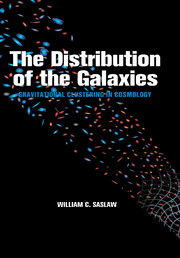Book contents
- Frontmatter
- Contents
- Prologue
- Part I Historical
- Part II Descriptions of Clustering
- Part III Gravity and Correlation Functions
- Part IV Gravity and Distribution Functions
- Part V Computer Experiments for Distribution Functions
- Part VI Observations of Distribution Functions
- Part VII Future Unfoldings
- Bibliography
- Index
Part VI - Observations of Distribution Functions
Published online by Cambridge University Press: 19 January 2010
- Frontmatter
- Contents
- Prologue
- Part I Historical
- Part II Descriptions of Clustering
- Part III Gravity and Correlation Functions
- Part IV Gravity and Distribution Functions
- Part V Computer Experiments for Distribution Functions
- Part VI Observations of Distribution Functions
- Part VII Future Unfoldings
- Bibliography
- Index
Summary
The heavens themselves, the planets, and this centre,
Observe degree, priority, and place,
Insisture, course, proportion, season, form,
Office and custom, in all line of order
ShakespearePhysics tries to discover the pattern of
events which controls the phenomena we observe.
JeansNot explanation, but prediction is our most stringent test of understanding. Many are the explanations after the fact; few are the predictions that agree with later observation. This holds especially for complex phenomena, whether of astrophysics, cosmology, economics, history, or social behavior.
When statistical thermodynamics first yielded distribution functions for cosmological many-body systems, neither simulations nor observations had been analyzed for comparison. Only Hubble's galaxy counts in the limit of large cells were known, though not to us at the time. Correlation functions then dominated studies of largescale structure.
Old simulations, after their spatial distribution functions were analyzed, first showed that the theory was reasonable. As a result, many new simulations, sketched in Part V, began to explore the range of conditions to which the theory applies; this exploration continues.
It took a couple of years to persuade observers to analyze distribution functions for modern catalogs. Would the distributions created by the great analog computer in the sky agree with those of digital computers here on Earth? Is the pattern of the galaxies dominated by simple gravitational clustering? The answer is still a continuing saga. Although observed spatial distribution functions are now moderately well studied, velocity distributions are just beginning to be determined, and predictions of past evolution remain to be observed in our future.
- Type
- Chapter
- Information
- The Distribution of the GalaxiesGravitational Clustering in Cosmology, pp. 427 - 428Publisher: Cambridge University PressPrint publication year: 1999



